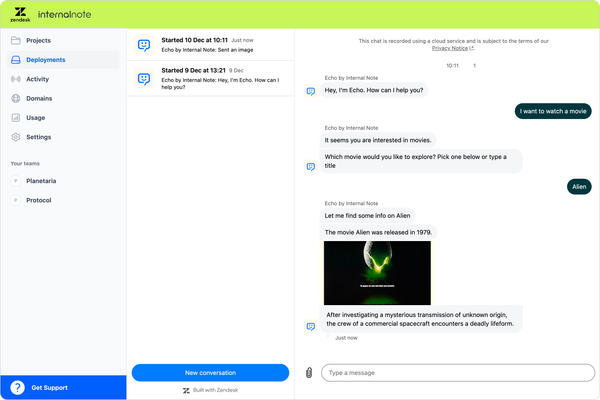
What's new from Zendesk Relate: WFM, QA and Zendesk’s new vision.
In today's newsletters I'll write about the to remaining topics: Workforce Management (WFM) and Quality Assessment (QA), and wrapping things up with some comment on Zendesk's new product vision.
The first part of this Relate series gave an overview of the Keynote and dove into the world of Zendesk AI, with AI Agents and the new Agent Copilot.
In today's newsletters I'll write about the to remaining topics: Workforce Management (WFM) and Quality Assessment (QA), and wrapping things up with some comment on Zendesk's new product vision.
Where Zendesk AI is an enhancement of Zendesk Support and a shift towards automation, WEM and QA are new directions for Zendesk that build on top of the existing Suite, further integrating Zendesk as a solution not only for traditional customer care, but offering options for managing the people who actually handle the tickets, and giving the same quality of support to the employees in your company.

Zendesk Workforce Engagement.
Introducing Zendesk WEM: Workforce Management en QA. AI Powered WEM is essential for AI-first service
Last year Zendesk bough Tymeshift, a leading workforce manager and scheduler that's been purpose built for Zendesk, and Klaus, an AI powered Quality Assurance tool.
This year we see the fruition of these two new additions to the Zendesk family with the launch of Zendesk WEM. A new suite of AI powered capabilities that add workforce management and QA to your Zendesk Suite.
It's a new suite of capabilities that's lives at the end of your CX lifecycle giving you insights in staffing, workloads and quality. Together with reporting you can use this data to improve your Zendesk setup and raise team efficiency and csat.
WFM - Workforce Management

The main value proposition of the new Zendesk WFM is this simple truth: of your company has too many agents then you'll have a high labor cost without a lot of agent efficiency. On the flip-side, if you have too few agents, you'll have an increased resolution time and angry or dissatisfied customers as a result.
Enter Zendesk WFM: Predictive Workforce Planning, the managing tool formerly known as Tymeshift.
The tool gives you insights in ticket volume, allows you to predict staffing and has an AI engine that dynamically creates your agents' schedule, assigning them to different channels to have the most efficient availability across your team.

Zendesk WFM will also allow you to track agents time so you get insight in average handle time, schedule adherence and, if you want, you can even track time spend outside of Zendesk, so you get an insight in the work done in your CRM, documentation or other online tools.
And to complete the feature set, the reporting dashboard gives you insight in unexpected ticket surges, allowing you to dynamically reassign your team to different channels.
Zendesk QA

Better ticket handling and higher quality customer interacts leads to happier customers. However, to get insight in how your agents are handling tickets team leads traditionally need to review tickets manually. This review process takes time and, according to Zendesk, they traditionally see only 1-2% of tickets getting an actual review.
This means 98% of your ticket interactions are left in the dark, and these unreviewed interactions are a potential disaster waiting to happen.
Enter Zendesk QA: an automated way to know the quality of all your interactions. The new tool checks the service quality of all tickets, surfaces potential coaching opportunities and highlights knowledge gaps at the agent level.
It also checks grammar, verifies if the ticket actually resolved the initial inquiry and flags interactions a team lead should review
And as a company you can also add additional checks to see if agents use your predefined greetings, use the right product names, and use the right tone of voice.
VoiceQA

Traditional QA tools run on text-based tickets like chat, social messaging or email. However, with the newly introduced VoiceQA Zendesk will now transcribe all phone calls your agents make with customers and leverage that info to do a full QA on those interactions too. Compatible with Zendesk Voice, Aircall and Amazon Connect, VoiceQA checks those interactions for sentiment, tone, dead air (silence) and all other elements mentioned in the previous section.
This means that, if you were already using Klaus, you now get insight in all your interactions across text and voice.
AutoQA for AI Agents

Aside from text and voice there's one major part of your customer interactions that should be measured and that's those of your AI Agent. Since up to 80% of customer interactions can be driven by your bot, it's important you can measure how accurate, and positive these interactions are. So with the new AutoQA for AI Agents you can now measure their performance the same way you would get data on your human interactions. (It still feels weird treating AI Agents as a real entity similar to humans. I sure hope we're not moving towards a Blade Runner future)
Spotlight

The last part of the QA announcements gave us Spotlight, a new Conversation Discovery Engine powered by Zendesk AI. It provides an overview of all your customer interactions and flags potential issues like churn risk.
You can then triage these conversations and escalate these customers so you can reach out and try to fix the issues going on.
My take
As I've described the second half of the AI announcements you might have noticed how unfamiliar I am describing these elements. Zendesk has always been a ticketing system at its core and writing about and working with automations, agent efficiency and self service has been a part of my professional carrier for over ten years now.
At last years' Relate Zendesk took their Zendesk Suite and sprinkled some AI magic on top of existing and familiar flows and product features. This years' Zendesk however breaks from that norm and re-envisions Zendesk as a complete new product approach.

Zendesk Suite now starts with being available to customers across any channel. You can automate that frontline and offer self service to your customers with the new AI Agents. Anything that bot can't handle is triaged and routed to the right team via Zendesk's intelligent triage powered by intent detection, sentiment analysis and the new queues and routing engine.
Once a ticket gets routed to the right team, the Agent Copilot, Knowledge panel with quick answers and the Intelligence panel gives agents an assist in automating and handling the ticket.
And finally the new WFM and QA tools allow you to make sure the right people are there to handle the influx of tickets, while keeping an eye on quality at the same time.

In this new Zendesk the existing Suite products (Help Center, Support, Messaging) are just parts of a bigger engine powered by Ultimate, Klaus, Tymeshift and Zendesk itself, bringing a cohesive and integrate story to companies who need a tool for CX and EX.
Is it perfect? No. There's still confusion about how the Ultimate/Zendesk Bot integration will go. The two products are still distinct entities and I can only assume it'll take another year to integrate the two platforms.
Similarly, even though the approach described about feels like a cohesive marketing story (and don't take this as a negative, I really like this new vision and approach), the actual product is still fractured when you look at it in detail. If you want to get a full insight in a tickets' journey, you need to get reporting insights from the new Bot insights dashboard to measure bot deflection rates, need to look at Explore to get insight in tickets, backlog and intents, and need to jump into the QA spotlight to detect quality and efficiency once tickets are closed. Three dashboard for three stages of a tickets journey.
That being said, Zendesk Relate has always been more about showing where Zendesk is steering its ship and giving us insight in the future, than being a celebration of past successes. Just like last years' Relate showed the initial version of Zendesk AI, which just came into fruition with the GA of all AI features right before Relate, I think next years' Relate will tell if Zendesk can deliver the story it told this week.
Thanks for reading!





